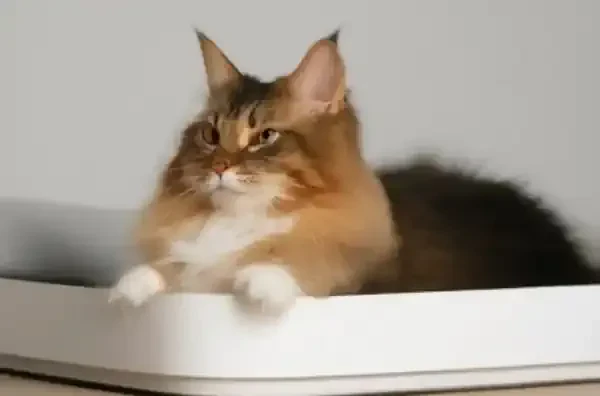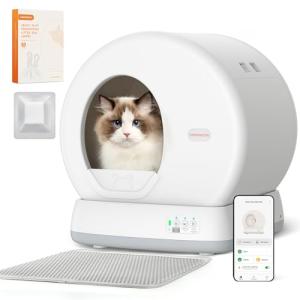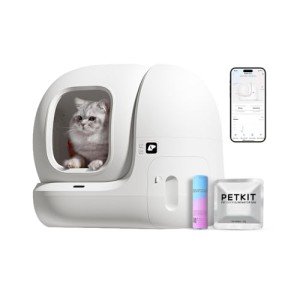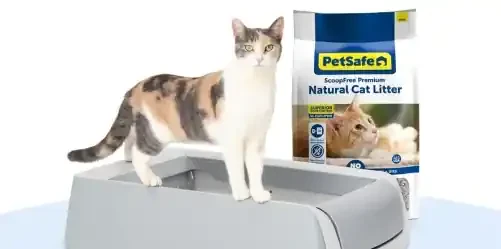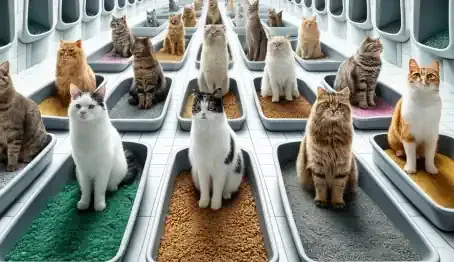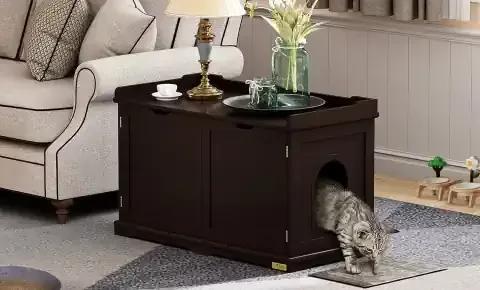The Essential Role of Cat Litter Boxes
Cat owners around the world understand the indispensable role that litter boxes play in maintaining harmony between human and feline cohabitants. Far beyond a mere convenience, these humble receptacles serve as crucial components of a cat's daily routine, contributing to their overall well-being and contentment. In this comprehensive guide, we delve into the significance of cat litter boxes, exploring their evolution, the diverse array of types available, and essential considerations for selecting and maintaining them.
The Importance of Cat Litter Boxes
For cats, maintaining proper hygiene is not just a matter of preference but a biological imperative. Instinctively clean creatures, cats have a natural inclination to bury their waste, a behavior rooted in their wild ancestors' survival instincts. In the absence of appropriate facilities, cats may resort to inappropriate elimination, leading to stress and discord within the household.
Enter the cat litter box – a sanctuary for felines to fulfill their toileting needs in a hygienic and controlled environment. Providing a designated space for elimination not only preserves household cleanliness but also fosters a sense of security and comfort for our beloved pets. Moreover, for indoor cats, litter boxes serve as essential tools for replicating the outdoor experience in a safe and controlled indoor environment.
Exploring the Diversity of Cat Litter Boxes
The world of cat litter boxes is as diverse as the cats who use them, offering a plethora of options to suit every feline fancy and owner preference. From traditional open trays to high-tech automated systems, the range of available designs is vast and varied. Covered boxes provide privacy and odor control, while self-cleaning models offer unparalleled convenience for busy pet owners. Top-entry litter boxes minimize litter tracking, while eco-friendly alternatives prioritize sustainability without compromising functionality.
Preview of Topics Covered
In the pages that follow, we embark on a journey through the evolution of cat litter boxes, tracing their historical roots and examining the factors driving their development. We delve into the intricacies of cat behavior and preferences, offering insights into creating the ideal litter box environment for your feline companion. From choosing the right litter box to maintaining a clean and odor-free space, we provide practical tips and expert advice to ensure harmony and happiness in your household.
Join us as we unravel the mysteries of the humble cat litter box, exploring its past, present, and future, and discover the key to a purrfectly blissful coexistence with your feline friend.
The Evolution of Cat Litter Boxes
Historical Background of Cat Litter Boxes
The concept of the cat litter box may seem like a modern convenience, but its origins can be traced back centuries. In ancient times, cats roamed freely outdoors, using natural materials like sand, soil, or even ashes to bury their waste. However, as the domestication of cats progressed and they became more integrated into indoor living environments, the need for a designated toileting area became apparent.
The earliest recorded evidence of indoor cat toileting solutions dates back to ancient Egypt, where sand-filled trays were used to accommodate the toileting needs of revered feline companions. Fast forward to the early 20th century, and the first commercially available cat litter made its debut, revolutionizing the way cats relieved themselves indoors. Initially consisting of absorbent materials like sand, sawdust, or shredded paper, these early litters paved the way for the development of modern cat litter as we know it today.
Development of Litter Box Materials and Designs Over Time
The evolution of cat litter boxes has been closely intertwined with advancements in materials science and pet care technology. As our understanding of feline behavior and preferences deepened, so too did our efforts to create litter boxes that catered to their unique needs.
Early litter boxes were often simple, shallow trays made from basic materials like plastic or metal. However, as demand for more functional and aesthetically pleasing options grew, manufacturers began experimenting with different shapes, sizes, and materials. Covered litter boxes, featuring hoods or enclosures to provide privacy and odor control, gained popularity in the latter half of the 20th century. This design innovation not only addressed concerns about litter tracking and odor but also appealed to cat owners seeking a more discreet solution for indoor toileting.
In recent years, the market has witnessed an explosion of innovation in litter box design, with manufacturers introducing features such as self-cleaning mechanisms, top-entry access, and eco-friendly materials. These advancements reflect a growing awareness of the importance of providing cats with a clean, comfortable, and stress-free toileting environment.
Influence of Cat Behavior Research on Litter Box Design
Central to the evolution of cat litter boxes has been ongoing research into feline behavior and preferences. Studies have revealed fascinating insights into the instinctual behaviors that drive cats' toileting habits, informing the design of litter boxes that better accommodate their needs.
For instance, research has shown that cats prefer litter boxes with ample space to maneuver and dig, as well as those positioned in quiet, low-traffic areas of the home. Additionally, studies have highlighted the importance of litter texture and scent in attracting cats to use the box and encouraging consistent toileting behavior.
By incorporating these findings into the design process, manufacturers have been able to create litter boxes that not only meet cats' functional requirements but also align with their natural instincts and preferences. This holistic approach to design has contributed to the development of litter boxes that promote better litter box compliance and overall feline well-being.
In summary, the evolution of cat litter boxes reflects a dynamic interplay between historical precedent, technological innovation, and scientific inquiry. From humble sand-filled trays to high-tech self-cleaning marvels, the journey of the litter box is a testament to our ongoing efforts to provide our feline companions with the best possible care and comfort.
Understanding Cat Behavior and Litter Box Preferences
Cats are creatures of habit, guided by a complex interplay of instincts and preferences when it comes to their toileting habits. To ensure harmony in the household and promote good litter box compliance, it's essential for cat owners to understand these behaviors and preferences.
Natural Instincts of Cats Related to Elimination
At their core, cats are fastidious creatures with a strong instinct to bury their waste. This behavior, inherited from their wild ancestors, serves multiple purposes, including minimizing scent trails that could attract predators and maintaining a clean living environment. Understanding and respecting these natural instincts is key to providing an environment in which cats feel comfortable and secure.
Factors Influencing Litter Box Preferences
Several factors can influence a cat's preference for using the litter box, ranging from the size and shape of the box to the type of litter used and its placement within the home.
Size and Shape of the Box: Cats prefer litter boxes that offer ample space to move around and dig. Boxes that are too small or restrictive may discourage cats from using them, leading to accidents outside the box.
Type of Litter Used: Cats have individual preferences when it comes to litter texture and scent. Some cats may prefer clumping litter, while others prefer non-clumping varieties. Similarly, scented vs. unscented litter can elicit different responses from cats, so it's essential to observe your cat's preferences and adjust accordingly.
Placement of the Litter Box: The location of the litter box within the home can significantly impact a cat's willingness to use it. Cats prefer quiet, low-traffic areas that offer privacy and security. Placing the litter box in a noisy or high-traffic area may cause cats to avoid using it altogether.
Cleanliness and Maintenance: Cats are meticulous creatures that prefer a clean toileting environment. Failure to scoop the litter box regularly or provide adequate cleaning and maintenance can lead to litter box aversion and inappropriate elimination.
Common Litter Box Problems and Their Causes
Despite our best efforts, litter box problems can still arise, often signaling underlying issues that require attention. Some common litter box problems include:
1. Avoidance of the Litter Box: Cats may avoid using the litter box for various reasons, including discomfort associated with the box itself, aversion to the litter type, or stress-related issues such as territorial disputes or changes in the household environment.
2. Inappropriate Elimination: Cats may urinate or defecate outside the litter box due to medical issues, behavioral problems, or dissatisfaction with the box's cleanliness or location.
3. Litter Box Aversion: Cats may develop aversions to the litter box if they associate it with negative experiences, such as painful urination or encounters with other pets.
By identifying the underlying causes of these problems and addressing them promptly, cat owners can often resolve litter box issues and restore harmony in the household. Regular monitoring of litter box behavior, coupled with proactive measures to address any issues that arise, is key to maintaining good litter box compliance and promoting feline well-being.
Types of Cat Litter Boxes
Cat litter boxes come in a variety of shapes, sizes, and designs, each offering unique features and benefits to suit the needs of both cats and their owners. From traditional open trays to innovative self-cleaning systems, the options are diverse and plentiful. Let's explore some of the most common types of cat litter boxes available on the market today.
Traditional Open Litter Boxes
The traditional open litter box is perhaps the most familiar and straightforward option. These simple trays typically feature low sides, making them easily accessible for cats of all sizes. Open litter boxes offer ample space for cats to move around and dig, and their simplicity makes them easy to clean and maintain. However, they may lack privacy and odor control compared to other types of litter boxes.
Covered Litter Boxes
Covered litter boxes, also known as hooded or enclosed litter boxes, feature a removable hood or cover that provides privacy and helps contain litter scatter and odors. Many cats appreciate the added privacy afforded by covered litter boxes, which can promote a sense of security and comfort. However, some cats may find the enclosed space too confining or may be deterred by the odors that can accumulate inside the box if it is not cleaned regularly.
Automatic/Self-Cleaning Litter Boxes
Automatic or self-cleaning litter boxes are a boon for busy cat owners who want to minimize the time and effort spent on litter box maintenance. These high-tech systems use sensors or timers to detect when a cat has used the box and automatically rake or sift the litter to remove waste. While self-cleaning litter boxes offer unparalleled convenience, they tend to be more expensive upfront and may require regular maintenance to ensure proper functionality.
Top-Entry Litter Boxes
Top-entry litter boxes feature a lid or cover with a small opening on top, requiring cats to enter and exit the box from above. This design helps contain litter scatter and prevents dogs or young children from accessing the litter. Top-entry litter boxes can be particularly beneficial for cats who tend to kick litter out of the box or prefer privacy while toileting. However, they may not be suitable for elderly or arthritic cats who have difficulty jumping or climbing.
5. Disposable Litter Boxes
Disposable litter boxes offer a convenient and hygienic solution for travel or temporary use. Made from lightweight and biodegradable materials, these boxes can be used as standalone litter boxes or as liners for traditional litter boxes. Disposable litter boxes are ideal for cat owners on the go or for situations where regular cleaning may be challenging.
Eco-Friendly and Sustainable Litter Box Options
For environmentally conscious cat owners, eco-friendly and sustainable litter box options offer a guilt-free alternative to traditional litter boxes. These options may include litter boxes made from recycled or biodegradable materials, as well as natural litter substrates such as wood, paper, or corn-based litter. By choosing eco-friendly litter box options, cat owners can reduce their environmental footprint while providing a safe and healthy toileting environment for their feline companions.
In summary, the wide range of cat litter box options available today ensures that cat owners can find the perfect solution to meet their cats' needs and preferences. Whether you opt for a traditional open tray, a high-tech self-cleaning system, or an eco-friendly alternative, providing a clean, comfortable, and inviting litter box environment is essential for promoting good litter box habits and overall feline well-being.
Choosing the Right Litter Box for Your Cat
Selecting the right litter box for your cat is essential to ensure their comfort, promote good litter box habits, and maintain a harmonious living environment. With a wide array of options available, it's important to consider factors such as your cat's needs and preferences, household dynamics, budget, and environmental impact when making your decision.
Assessing Your Cat’s Needs and Preferences
Every cat is unique, with individual preferences and behaviors that can influence their choice of litter box. Before making a selection, take the time to observe your cat's toileting habits and preferences. Consider factors such as their size, age, mobility, and personality when choosing a litter box. Some cats may prefer open trays for easy access, while others may feel more secure in covered or top-entry boxes. Pay attention to your cat's litter preferences as well, including litter texture, scent, and depth.
Considerations for Multi-Cat Households
If you have multiple cats, it's important to take their dynamics into account when selecting litter boxes. Experts recommend providing one litter box per cat, plus an additional box to minimize competition and reduce the likelihood of litter box-related conflicts. Opt for larger, spacious litter boxes to accommodate multiple cats comfortably, and consider placing them in separate areas of the home to provide privacy and minimize territorial disputes.
Budgetary Considerations
Litter boxes are available at a wide range of price points, from budget-friendly basic models to high-end, feature-rich options. Consider your budget when choosing a litter box, but keep in mind that quality and durability are also important factors to consider. While it may be tempting to opt for the cheapest option available, investing in a well-made, durable litter box can save you money in the long run by reducing the need for frequent replacements.
Environmental Impact and Sustainability
In recent years, there has been a growing awareness of the environmental impact of traditional clay-based cat litters, which can contribute to landfill waste and strip-mining of natural resources. Fortunately, there are now eco-friendly and sustainable litter box options available that minimize environmental impact. Look for litter boxes made from recycled or biodegradable materials, as well as natural litter substrates such as wood, paper, or plant-based materials. Additionally, consider using litter box liners or reusable litter mats to reduce waste and make cleanup easier.
By carefully considering your cat's needs and preferences, household dynamics, budget, and environmental impact, you can choose a litter box that meets both your cat's needs and your own preferences. Providing a clean, comfortable, and inviting litter box environment is essential for promoting good litter box habits and ensuring the health and well-being of your feline companions.
Maintaining a Clean and Healthy Litter Box Environment
Ensuring a clean and hygienic litter box environment is crucial for promoting good litter box habits and safeguarding the health and well-being of your feline companions. From proper placement to regular cleaning routines, here are some essential tips for maintaining a clean and healthy litter box environment.
Proper Litter Box Placement in the Home
The location of the litter box within your home can significantly impact your cat's willingness to use it and their overall litter box habits. Choose a quiet, low-traffic area of the home where your cat feels safe and secure. Avoid placing the litter box near noisy appliances, high-traffic areas, or areas where your cat may feel trapped or cornered. Additionally, ensure that the litter box is easily accessible to your cat at all times, especially if you have senior or mobility-impaired cats.
Cleaning and Scooping Routines
Regular cleaning and scooping are essential for maintaining a clean and odor-free litter box environment. Establish a daily scooping routine to remove solid waste and clumps of urine from the litter box. Use a sturdy litter scoop designed for your chosen litter type, and dispose of waste in a securely sealed bag or waste bin. Additionally, perform a thorough cleaning of the litter box and surrounding area at least once a week. Empty the litter, scrub the box with mild soap and water, and thoroughly rinse and dry before refilling with fresh litter.
Tips for Minimizing Litter Tracking and Odor
Litter tracking and odor can be common challenges associated with litter box maintenance, but there are several strategies you can employ to minimize these issues. Place a litter mat or tray outside the litter box to capture stray litter and prevent it from spreading throughout the home. Consider using a litter box with high sides or an enclosed design to contain litter scatter and minimize tracking. Additionally, choose a high-quality litter with excellent odor control properties, and consider adding baking soda or activated charcoal to further neutralize odors.
Health Considerations Related to Litter Box Hygiene
Maintaining a clean and hygienic litter box environment is not only essential for your cat's comfort but also for their overall health and well-being. Dirty or soiled litter boxes can become breeding grounds for bacteria, parasites, and other pathogens that can pose health risks to both cats and humans. In addition to regular cleaning and scooping, monitor your cat's litter box habits closely for any signs of illness or discomfort, such as changes in frequency or consistency of urination or defecation. If you notice any abnormalities, consult your veterinarian promptly for further evaluation and treatment.
By following these tips for maintaining a clean and healthy litter box environment, you can ensure that your cat has a comfortable and hygienic place to fulfill their toileting needs, while also promoting good litter box habits and minimizing health risks for both you and your feline companions.
Troubleshooting Common Litter Box Issues
While maintaining a clean and healthy litter box environment is essential, cat owners may still encounter various issues related to litter box usage. From litter aversion to territorial disputes, here are some common litter box problems and effective strategies for troubleshooting them.
Addressing Litter Aversion and Refusal
Litter aversion occurs when a cat avoids using the litter box altogether, often choosing to eliminate in inappropriate locations instead. Several factors can contribute to litter aversion, including discomfort associated with the litter type, box size, or location, as well as stress or anxiety related to changes in the household environment. To address litter aversion, start by evaluating the litter box setup and making necessary adjustments, such as switching to a different litter type or texture, providing additional litter boxes in different locations, and ensuring a quiet and secure environment for toileting. Gradually reintroduce your cat to the litter box using positive reinforcement techniques, such as treats or praise, to encourage them to use it consistently.
Dealing with Inappropriate Elimination
Inappropriate elimination occurs when a cat urinates or defecates outside the litter box, often on carpets, furniture, or other household surfaces. This behavior can be distressing for cat owners and may indicate underlying issues such as medical problems, stress, or territorial disputes. To address inappropriate elimination, start by ruling out any potential medical causes by consulting with your veterinarian. Once medical issues have been addressed, focus on identifying and addressing any underlying behavioral or environmental factors contributing to the problem. Provide multiple clean litter boxes in different locations, address any sources of stress or anxiety in the household, and use deterrents such as double-sided tape or aluminum foil to discourage urination or defecation in inappropriate areas.
Managing Territorial Issues in Multi-Cat Households
Territorial issues can arise in multi-cat households, leading to conflicts over litter box usage and marking behavior. Cats are territorial animals by nature and may engage in scent marking behavior to establish and defend their territory. In some cases, one dominant cat may prevent other cats from accessing the litter box, leading to litter box avoidance or inappropriate elimination. To manage territorial issues in multi-cat households, provide multiple litter boxes in different locations throughout the home to reduce competition and provide each cat with their own space. Additionally, create a positive and stress-free environment by providing plenty of vertical and horizontal space, as well as opportunities for play, enrichment, and social interaction.
Solutions for Litter Box Aggression
Litter box aggression occurs when one cat intimidates or bullies another cat while they are using the litter box, leading to stress, anxiety, and avoidance behavior. This behavior can be particularly problematic in multi-cat households and may require intervention to resolve. To address litter box aggression, provide multiple litter boxes in different locations to reduce competition and minimize the likelihood of confrontations. Additionally, create a positive and relaxed atmosphere around the litter boxes by providing ample space, privacy, and resources for each cat. Use positive reinforcement techniques to encourage calm and non-aggressive behavior, and consider consulting with a veterinarian or animal behaviorist for further assistance if needed.
By addressing common litter box issues promptly and effectively, cat owners can help promote good litter box habits and maintain a harmonious and stress-free environment for their feline companions.
DIY Solutions and Hacks for Cat Litter Boxes
For cat owners looking to get creative or save some money, DIY solutions and hacks offer innovative alternatives to traditional litter boxes. From homemade litter box alternatives to repurposing common household items, and even crafting stylish litter box furniture, here are some DIY ideas to consider.
Homemade Litter Box Alternatives
When it comes to litter boxes, sometimes simplicity is key. For a quick and easy DIY solution, consider making a homemade litter box using basic materials you likely already have at home. Large plastic storage containers, such as storage bins or under-bed storage boxes, can be repurposed into makeshift litter boxes by cutting a small entrance hole in one side. These containers offer ample space for your cat to move around and dig, and their high sides help contain litter scatter and prevent accidents.
Alternatively, consider using disposable items such as cardboard boxes or aluminum baking trays as temporary litter boxes. While not as durable as traditional litter boxes, these makeshift alternatives can be useful in a pinch or for travel purposes.
Creative Ways to Repurpose Common Household Items for Litter Box Use
Get creative with repurposing common household items into functional and stylish litter box solutions. For example, consider converting an old cabinet or side table into a concealed litter box enclosure by removing the door or creating a discreet entrance for your cat. Line the interior with a waterproof liner or plastic tray to contain spills and make cleaning easier.
You can also repurpose storage ottomans or benches with removable lids into hidden litter box compartments. Simply cut a hole in one side for your cat to enter and exit, and use the interior space to conceal the litter box while providing your cat with privacy.
For a more whimsical touch, consider transforming an unused suitcase or vintage trunk into a charming litter box hideaway. Line the interior with a waterproof liner or plastic tray, and add a soft cushion or mat for your cat's comfort.
DIY Litter Box Furniture and Enclosures
For cat owners who value both functionality and aesthetics, DIY litter box furniture and enclosures offer a stylish and practical solution. Build a custom litter box cabinet or enclosure using plywood, wood panels, and hinges. Incorporate features such as a hinged top or sliding door for easy access to the litter box, as well as ventilation holes to promote airflow and reduce odors.
Alternatively, repurpose existing furniture such as old dressers, nightstands, or bookshelves into multi-functional litter box enclosures. Remove drawers or shelves to create space for the litter box, and add a decorative curtain or door to conceal the opening when not in use.
By getting creative with DIY solutions and hacks, cat owners can customize their litter box setup to suit their preferences and budget while providing their feline companions with a comfortable and inviting toileting environment. Whether you opt for homemade litter box alternatives, repurposed household items, or custom-built litter box furniture, DIY solutions offer endless possibilities for enhancing your cat's litter box experience.
The Future of Cat Litter Boxes
As technology advances and consumer preferences evolve, the landscape of cat litter boxes is undergoing a transformation. From cutting-edge innovations in design to a growing emphasis on sustainability and eco-friendliness, the future of cat litter boxes promises exciting developments that cater to both cats and their owners.
Emerging Technologies in Litter Box Design
The integration of technology into litter box design is revolutionizing the way cat owners manage their pets' toileting needs. One notable advancement is the rise of smart litter boxes equipped with sensors and automated features. These high-tech systems can detect when a cat enters and exits the litter box, monitor usage patterns, and even analyze urine for signs of health issues. Some smart litter boxes also offer self-cleaning capabilities, using robotic mechanisms to remove waste and maintain a clean litter bed. With smartphone connectivity and remote monitoring capabilities, these innovative litter boxes provide convenience and peace of mind for busy cat owners.
Trends in Sustainable and Eco-Friendly Litter Box Options
In response to growing environmental concerns, there is a rising demand for sustainable and eco-friendly litter box options. Manufacturers are exploring alternative materials and production methods that minimize environmental impact without sacrificing functionality. Eco-friendly litter boxes may be made from recycled materials, biodegradable plastics, or natural fibers such as bamboo or hemp. Additionally, there is a growing trend towards compostable litter options that can be safely disposed of and recycled back into the environment. By choosing sustainable litter box options, cat owners can reduce their ecological footprint and contribute to a more environmentally friendly future.
Innovations in Addressing Cat Behavior and Litter Box Preferences
Advancements in cat behavior research are driving innovations in litter box design that cater to cats' natural instincts and preferences. Manufacturers are developing litter boxes with features that mimic outdoor environments, such as larger dimensions, varying textures, and natural materials. Some litter boxes also incorporate pheromone-based attractants or calming scents to encourage cats to use the box consistently. By taking a holistic approach to design that considers both cat behavior and owner preferences, these innovative litter boxes are revolutionizing the way cats experience toileting indoors.
In conclusion, the future of cat litter boxes is filled with promise, as emerging technologies, sustainability initiatives, and insights into cat behavior shape the next generation of litter box design. With smart features, eco-friendly materials, and a focus on meeting cats' unique needs and preferences, the litter boxes of tomorrow are poised to enhance the well-being of both cats and their owners in exciting new ways.
Conclusion
As we conclude our exploration of cat litter boxes, it's essential to reflect on the key points covered throughout this article and underscore the importance of providing an appropriate litter box environment for our feline companions.
Recap of Key Points Covered in the Article
Throughout this article, we've examined the evolution of cat litter boxes, from their historical origins to the diverse array of options available today. We've explored the factors influencing cat behavior and litter box preferences, as well as practical tips for choosing, maintaining, and troubleshooting litter boxes. From traditional open trays to high-tech self-cleaning systems, there is a litter box solution to suit every cat and owner.
Final Thoughts on the Importance of Providing an Appropriate Litter Box Environment for Cats
The litter box plays a vital role in the health, happiness, and well-being of our cats. By providing a clean, comfortable, and inviting litter box environment, we help fulfill our cats' natural instincts and promote good litter box habits. A well-maintained litter box not only reduces the risk of litter box aversion and inappropriate elimination but also fosters a harmonious and stress-free living environment for both cats and their owners.
Encouragement for Further Exploration and Experimentation with Litter Box Options
As cat owners, it's essential to remain open-minded and proactive in our approach to litter box care. With an ever-expanding range of litter box options available, there is always room for exploration and experimentation. Whether it's trying out a new litter type, experimenting with DIY solutions, or embracing emerging technologies, don't be afraid to think outside the box (pun intended) and find what works best for you and your cat.
In conclusion, providing an appropriate litter box environment is not just a matter of convenience—it's a fundamental aspect of responsible cat ownership. By understanding our cats' needs and preferences and investing time and effort into maintaining a clean and comfortable litter box environment, we can ensure the health, happiness, and well-being of our beloved feline companions for years to come.
